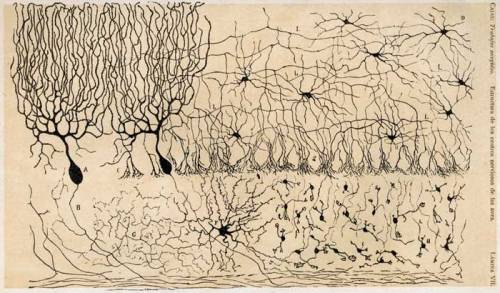He painstakingly spent hours staining nerve cells so he could then spend days staring at them under a microscope. As he observed their every detail, he would make drawings of all the cells and nerve connections he saw. We owe a lot of what we know about the microscopic anatomy of the brain because of his efforts.
 |
| one of Cajal's drawings |
He also studied how nerve cells develop in a fetus and hypothesized theories we use today. Back when scientific writing was free from its boring, unclear jargon we find in today's journals, he described how nerve cells began and finished their developmental growth into mature circuits.
He wrote about how nerve cells grow out elongated "finger-like" processes moved by some "mysterious forces" that "precede the appearances of these processes". These fingers start in an area, like the future spinal cord, searching for their final destiny in a specific location (another cell in the brain) which was somehow specified even before the birth of this nerve cell. Thus, the cell begins its journey to find its "soul mate" if you will. Cajal wrote that when the cells arrive at their destination, they get to "finally establish those protoplasmic kisses...which seem to constitute the final ecstasy of an epic love story."
Such a simple and elegant story about our beginnings. Science can indeed be beautiful.

No comments:
Post a Comment